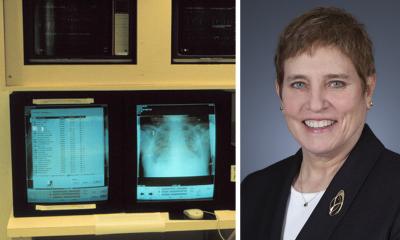
Image source: Adobe Stock/amorn
Article • Tackling gender inequality
Radiology – still a “man’s world”?
A panel of experts assessed the challenges women have to face in radiology and explored strategies to help tackle gender inequalities at ECR 2023 in Vienna, Austria.
Report: Mélisande Rouger
As populations become increasingly diverse, organizations need to adapt, Laura Oleaga, MD, PhD, told the audience. ‘Gender equity is a key factor in achieving excellence in academic medicine,’ the professor of radiology and the former chief of the radiology department at the Hospital Clinic in Barcelona, Spain, said. ‘It contributes to excellence in all professions, allowing for a global vision of all situations from different perspectives and sensitivities.’

Image source: ESR
So far, however, this is only partly reflected in reality: While the proportion of women in academic medicine is similar to men, the proportion of female professors is significantly lower, the expert pointed out, sharing data from the UNESCO. ‘In 2019, the proportion of women heads of institutions in higher education was 23.6%, and they made up 31.1% of the members of scientific boards,’ she said. ‘Women represented 33.8% of all researchers in the EU in 2018, and as we go up in the career pyramid, the number of women decreases.’ Forty-eight percent of all doctoral students were women, while they represented 24% of the highest roles in academia. In Europe, women represent 54% of physicians and 40% of radiologists. Female representation in radiology decreases at increasing levels of leadership, she noted.
According to an article published in European Radiology, 30% of ESR members were women in 2019, with substantial generational differences, especially between the traditionalist group and millennials.1 ‘Women represented 13% of the members born between 1927 and 1945, and 41% of those born between 1977 and 1992,’ she said.
Women underrepresented in crucial future fields
Radiology is a technological field, an area where women remain a minority, Prof. Oleaga pointed out. ‘There are less women in digital information technology, computing, physics, mathematics, engineering and AI. We have to pay attention to that, because these are the fields that are driving many of the future jobs.’ The percentage of women with AI skills is much lower than men, and women are also leaving technological fields in greater numbers than men. ‘This trend makes us think that progress towards gender balance could be compromised,’ she said. ‘We have to promote scholarships to attract women in technology and to incorporate and retain them in these fields.’
Recommended article

Video • 'Women in Focus' at ECR
Getting to the top, staying feminine
Women continue to lead a rather marginal existence in medicine. Although there are now more female than male medical students, professorships and directorships are almost exclusively held by men. This imbalance was addressed with the lecture series ‘Women in Focus’ at the 2019 European Congress of Radiology (ECR).
To influence change, increasing the number of female role models and mentors is essential, the radiologist explained. ‘A lack of mentorship and role mentoring may be deterring women from pursuing radiology,’ she said. ‘Mentorship and sponsorship of women programs directly impact female advancement and career satisfaction. Leadership and management programs represent effective ways to cultivate leadership skills to promote the professional career.’ Building a connecting network of female radiologists in coaching and leadership programs including promotions and career changes could further help prepare future radiologists, she concluded.
A young radiologist mum’s perspective

Image source: X/@CarolynHorst3
The next speaker, Dr Carolyn Horst from Kings College London, UK, shared her perspective as a radiology trainee with the delegates. She showed a picture of her two-year-old daughter as part of her disclosures. ‘Having a child as a female physician can feel like something you have to disclose,’ she said. ‘I say this jokingly, but it can feel like something that hampers you professionally.’
To prove this point, she then talked about her non-linear training story, starting medical school when she was 28, and then working as a junior doctor for two years, as she was always told her career would go. Until she decided to embark on a PhD and have a baby. ‘I took an eight-month break to have my child, and now I’m back in radiology training and still have a couple more years before I reach the golden field of consultants,’ she said. ‘The truth is it doesn’t always happen the way you’ve been told it was going to happen, especially when you have a family.’ In the UK, the expectation for trainees is that they are young, willing and able to move anywhere they might be needed, may have some independent financial means if they stay in London, and have no caring responsibilities, she explained. ‘This approach diverts good trainees with any or all of the above pressures to GP and other specialties, which have short and less popular training schemes,’ she said.
‘We have an image problem’
In the UK, only 37% of consultant radiologists are female, even though there has been parity of men and women in medical schools for decades. ‘We have an image problem,’ Dr Horst said. ‘Women like working in a team. The perception of what radiologists do is that they’re sitting in a dark room alone and looking at their screen.’ In addition, there is a structural problem with regards to the way radiology is being taught. ‘The apprenticeship model is often successful when the trainer is like the trainee. So, we need women training other women.’
Radiology also lacks presence in the medical board, and radiology is often totally new for trainees. Finally, women with caring responsibilities tend to be seen as ‘uncommitted’ because they leave after they have completed their work to pick up children – and don’t have time to stay and talk with colleagues.
Victoria Pozniakova, a radiologist at Stavanger University Hospital in Norway and vice president of the Norwegian Society of Radiology, and Cindy Chew, associate professor at Glasgow University, UK and President-elect of the Scottish Society of Radiology, also spoke in the session.
Literature:
Profiles:
Laura Oleaga is Professor of Radiology at Barcelona University and the former Head of the Radiology Department at the Hospital Clinic in Barcelona, Spain. She is the Scientific Director of the European Diploma in Radiology (EDiR) and a former Vice President of the Spanish Society of Radiology (SERAM). In 2020, she was elected Most Effective Radiology Educator by Aunt Minnie.
Dr Carolyn Horst is an NIHR Academic Clinical Fellow, currently working at King’s College London and Guy's & St Thomas' NHS Foundation Trust, UK. She is a Trainee Editorial Board member for the Radiology journal. She has completed her PhD on low dose screening in 2020.
07.12.2023










